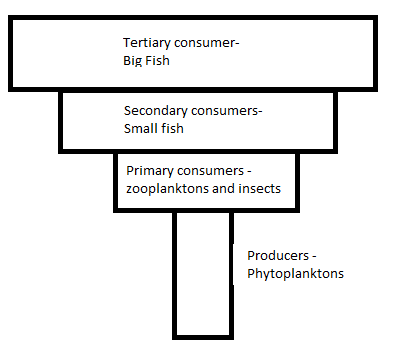
An ecological pyramid of biomass is often an inverted pyramid in which of the following ecosystems?
A) Desert
B) Ocean
C) Tundra
D) Rainforest
Answer
517.2k+ views
Hint: The ecological pyramid of biomass becomes inverted when the mass of producers in an ecosystem is less than the successive consumers.
Complete answer:
Before we try to figure out where and how an ecological pyramid is inverted, first of all let’s define the ecological pyramids.
An ecological pyramid is a graphical representation of a food chain, depicting the interrelationships of different organisms, occupying different trophic levels based on their feeding habit.
In a typical ecological pyramid, the base is occupied by the producers, followed by the primary consumers, secondary consumers, tertiary consumers and top carnivores. The ecological pyramids have a disadvantage that they do not provide appropriate representation of decomposers.
Now, there are following types of ecological pyramids:
1) Pyramid of energy that shows the flow of energy in an ecosystem. It is always upright because energy is lost at each trophic level in the form of heat and respiratory losses.
2) Pyramid of numbers that depicts the number of organisms at each trophic level. Generally, the producers are the largest in numbers, followed by a gradual decrease in number of consumer organisms. So, it is upright. A somewhat inverted pyramid of numbers is seen when a tree is a producer and is supporting a number of organisms.
3) Pyramid of biomass shows the relation between organisms occupying the different trophic levels based on their biomass. So, if in a given ecosystem, the producers are bulky, the pyramid of biomass will be upright and if the producers have low biomass, it becomes inverted.
An inverted pyramid of biomass is seen in oceans or aquatic ecosystems where the producers are phytoplanktons. Their number is quite large but their biomass is less than zooplanktons and so on.
An inverted pyramid of biomass in ocean is shown below:

Therefore, the correct answer is option B.
Note: The biomass of producers in desert and rainforest is way too more than the consumers, so they show an upright pyramid of biomass.
Complete answer:
Before we try to figure out where and how an ecological pyramid is inverted, first of all let’s define the ecological pyramids.
An ecological pyramid is a graphical representation of a food chain, depicting the interrelationships of different organisms, occupying different trophic levels based on their feeding habit.
In a typical ecological pyramid, the base is occupied by the producers, followed by the primary consumers, secondary consumers, tertiary consumers and top carnivores. The ecological pyramids have a disadvantage that they do not provide appropriate representation of decomposers.
Now, there are following types of ecological pyramids:
1) Pyramid of energy that shows the flow of energy in an ecosystem. It is always upright because energy is lost at each trophic level in the form of heat and respiratory losses.
2) Pyramid of numbers that depicts the number of organisms at each trophic level. Generally, the producers are the largest in numbers, followed by a gradual decrease in number of consumer organisms. So, it is upright. A somewhat inverted pyramid of numbers is seen when a tree is a producer and is supporting a number of organisms.
3) Pyramid of biomass shows the relation between organisms occupying the different trophic levels based on their biomass. So, if in a given ecosystem, the producers are bulky, the pyramid of biomass will be upright and if the producers have low biomass, it becomes inverted.
An inverted pyramid of biomass is seen in oceans or aquatic ecosystems where the producers are phytoplanktons. Their number is quite large but their biomass is less than zooplanktons and so on.
An inverted pyramid of biomass in ocean is shown below:

Therefore, the correct answer is option B.
Note: The biomass of producers in desert and rainforest is way too more than the consumers, so they show an upright pyramid of biomass.
Recently Updated Pages
Master Class 11 Physics: Engaging Questions & Answers for Success

Master Class 11 Chemistry: Engaging Questions & Answers for Success

Master Class 11 Biology: Engaging Questions & Answers for Success

Class 11 Question and Answer - Your Ultimate Solutions Guide

Master Class 11 Business Studies: Engaging Questions & Answers for Success

Master Class 11 Computer Science: Engaging Questions & Answers for Success

Trending doubts
The Equation xxx + 2 is Satisfied when x is Equal to Class 10 Maths

Gautam Buddha was born in the year A581 BC B563 BC class 10 social science CBSE

Which one is a true fish A Jellyfish B Starfish C Dogfish class 10 biology CBSE

Fill the blanks with proper collective nouns 1 A of class 10 english CBSE

Why is there a time difference of about 5 hours between class 10 social science CBSE

What is the median of the first 10 natural numbers class 10 maths CBSE




